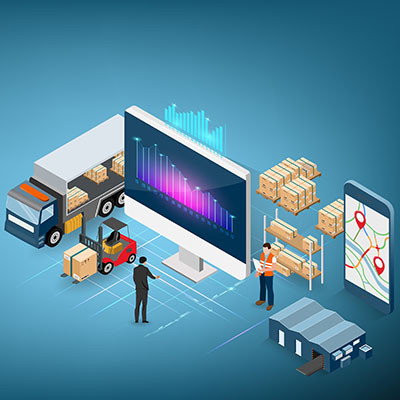k_Street Consulting, LLC Blog
Have you ever searched for something on Google, played a game that remembers your high scores, or checked your Instagram messages? These apps feel smooth and efficient thanks to something called a Database Management System (DBMS) working quietly in the background. In this month’s newsletter, we’ll explore what a DBMS is, how it works, and why it’s essential for creating a seamless user experience.
Using AI is all the rage these days. Seemingly every opportunity software developers have to add some type of AI or machine learning technology into their offerings is being taken; not only for the benefits that it gives their customers, but also for the marketing clout it immediately provides. This month, we thought we’d go into some of the ways AI is helping create more dynamic software and if it really provides end user value or if it’s kind of a red herring used by developers to position their products better in a more competitive market.
Artificial intelligence is the latest IT buzzword that everyone seems to focus on and it’s because it is a big deal. Advances in computing have created an environment where developers can create software that effectively learns. Unfortunately, due to the nature of AI regulation; or, the complete lack of it, there are some who are concerned that the technology—which could be a revolutionary tool for the improvement of human societies—is being degraded.
Artificial intelligence, or AI, has upended the way that we discuss technology in business, society, and individual everyday life. While we mostly focus on the benefits of the technology, there are many downsides to consider as well. That’s what we’d like to discuss today; how AI has a dark side to it that potentially requires regulation.
Downtime can be lethal to businesses, not only because too much can lead to failure, but it can easily waste a lot of your team’s time as everyone shifts gears to find a solution. This is why is it best to avoid it as often as possible.
That’s why we’re discussing three of the most prevalent causes of downtime, and what you can do to prevent them.
For the longest time, smartphone manufacturers looked to develop devices that came with unique features in all different manners of form factors. Nowadays, however, there are very few phone manufacturers and those that are left have pretty much decided, for now, what the smartphone would look like. Even the ones that fold in half look and function pretty much the same. In this week’s blog, we will take a look at the declining innovation in the smartphone market and why it may not be a bad thing.
The tech we have at our fingertips has the potential to dramatically enhance our productivity, support a great deal of creativity, and improve a person’s overall quality of life. What happens when you don't use this technology to its full potential? The answer is simple: you lose out. Let’s take a look at some of the negative effects of not using tech to its fullest.
A business has to have people who know how to balance its spending to cover its bases and keep the company healthy. For the small business it is often a matter of choices. In this month’s newsletter, let’s go through some of the ways that keeping it simple might just be the best strategy in terms of their technology.
There’s no doubt that data is valuable. It can improve many different aspects of a business, most notably operations, customer relations, and marketing. The more data you have, the more specific actions you can take to improve your business. But it can also be a real problem if you don’t have a plan for managing it. Let’s discuss some problems your data can present and how to avoid them.
Your computer has a brain, of sorts, in its CPU… a tiny square that literally enables everything the device does, as it processes billions of instructions at a time. Of course, to support this on such a relatively tiny piece of hardware, most CPUs are packed with microscopic transistors—these transistors being small enough to fit hundreds on a single blood cell.
As you might imagine, this means things can go wrong pretty easily… and gone wrong, things have. Many newer computers are suffering from a bug that could cause permanent damage to the CPU… and if you don’t take steps fast, it could be too late.
No matter your industry, size, or business model, satisfying your customers is crucial. Your business' survival depends on your ability to do this effectively.
To achieve this, it is essential to leverage every opportunity to deliver for your audience. One way to do this is through modern business technology, such as customer relationship management (CRM). Let's explore what a CRM is and why it's beneficial.
Do you have trouble keeping up with your email inbox? You’re not alone; business professionals all over the world struggle to get to the fabled “inbox zero.” If you want to change the way you manage your inbox for the better, you should consider the RAD method. It might just change your life.
The proposed ideas here come from Nick Sonnenberg, founder and CEO of Leverage.
Doing business using the cloud is now commonplace, but every business is different and needs to fit its IT infrastructure to its operational requirements. This is possible, but trying to fit a one-size-fits-all solution into a complicated operational structure will cause more harm than good. In this month’s newsletter, we wanted to give five general tips to consider when you want to deploy the cloud in your business.
Automation has been a hot-button issue in the business world over the past few years. Many business owners have tried to find ways to automate some of their operations, while workers wonder if this strategy develops as people in the know suggest it will, they could be out of a job. We think that automation is actually a massive benefit for organizations and workers alike. This month we will go through a few tools that small businesses can easily leverage to use automation to their advantage by taking a look at some of the tools that companies depend on.
With little fanfare, the AI Wars have begun. When we say “war” we mean just that: a battle for the survival of tools designed to improve human productivity. To start we should rewind a little. Most new software platforms (and many, many established ones) have started to use “artificial intelligence” to improve their products, or at least improve the prospect of selling them. In this week’s blog we will discuss the increased prevalence of “AI” and how some of the largest names in computing have gone all in on the technology.
When someone mentions cookies, people start paying attention. Chocolate chip, oatmeal raisin, snickerdoodles… Browser? While Browser cookies aren’t the most scrumptious, they do need some attention. Nowadays, many websites you visit have a popup asking if they want to allow cookies for that site and knowing what you are agreeing to is important. In today’s blog, we will describe what cookies are, how they work, and why they can sometimes be better than cookies with chocolate chips.
Big data has become an invaluable asset, not just for large corporations but also for small businesses. Using the vast amounts of data your business creates to help you make more effective decisions is easier than ever. In this month’s newsletter, we’ll look at how small businesses are tapping into the power of big data:
Every business is looking to technology to enhance their ability to support their operations and provide a better customer experience. Maximizing the value you get from your technology involves a combination of optimizing usage, staying updated, and using the tools and resources you’ve chosen efficiently. Here are some strategies:
The past several years have brought about dramatic increases in internet speeds, further fueling online activity and allowing businesses to innovate in all kinds of ways. Here are five of the best benefits that these increased Internet speeds have brought about for small and medium-sized businesses.
You can’t take two steps outside of your home or two mouse-clicks or screen-taps online without seeing something written or hearing someone talking about AI. This has created a situation where every business is claiming AI as a revolutionary tool and consumers, overwhelmed with the term, have begun to take the technology for granted. In today’s blog, we want to determine whether AI brings added value or is just a term used to help companies market their products.
Business can get messy, particularly when variables outside your control are involved, which could spell doom for your organization. We’re talking, of course, about instances where your organization might be under a particularly large threat—instances where your data is at risk, which could jeopardize your future. Thankfully, there are options to mitigate this risk.
Nowadays, finding a business that does not use technology in its everyday processes would be extremely challenging. That’s just how things are today. This technology also typically sees advances in capabilities and accessibility, particularly for the small and medium-sized business sectors. This year, 2024, seems poised to be no exception.
Firewalls are a mainstay of network security. At its core, the firewall acts as a barrier between a trusted internal network and untrusted external networks, such as the Internet. Its primary function is to monitor and control incoming and outgoing network traffic based on predetermined security rules. Think of the firewall as a gatekeeper scrutinizing every packet of data that attempts to pass through. Let’s take a look at the different types of firewalls and some of their key functions.
Augmented reality is one of the more intriguing technologies that have come along in recent years, and businesses have begun to use it in pretty interesting ways. In today’s blog, we thought we’d go through three of the most popular and effective use cases of AR and the effect it can have on your business.
More small and medium-sized businesses than ever are seeing AI's potential to transform their operations. However, like any technology, AI has its own set of pros and cons. Let's discuss three major advantages and drawbacks you can expect if using it in your business. Hopefully, it helps you make an informed decision about adopting AI.
Running a business has definite highs and lows. When things start spiraling seemingly out of control, it’s important to maintain the confidence that with the right decision-making and conscientious action, you can get through any problem that a business faces. In today’s blog, we’ll discuss some of the technology that can help you get through tough situations.
How can you know when your organization should upgrade its technology infrastructure? The truth is that it’s not always immediately obvious when you should do so, as there are countless factors in play to consider at any given time. Today, we want to help your business determine when to bite the bullet and upgrade your technology.
As necessary as technology is in modern business operations, a variety of common IT-related obstacles must be overcome for your efforts to succeed. Fortunately, partnering with a managed service provider (MSP) can make these obstacles less “mountain” and more “molehill.” Let’s examine some of the most often seen business technology challenges and discuss how a relationship with an MSP helps alleviate them.
Most businesses need to confront IT innovation, as technology moves pretty fast. If you don’t have a plan to at least consider the technology, you could be easily left in the dust. In this month’s newsletter, we will discuss some pretty transformative technologies that are evolving quickly and can help your business improve its overall innovation.
You’ve probably heard of augmented reality by now. If you are a fan of sports on TV, especially. Every time your favorite team faces a 4th and 1, the lines that you may take for granted on the field is AR. It augments the image with overlays of information that makes what you are looking at more immersive. As businesses continue to evolve, integrating augmented reality can be a game-changer. Let's explore four compelling ways in which augmented reality can work wonders for businesses.
The web is filled with all types of content, and depending on where you live, it can be regulated by a myriad of organizations from all sections of society. From internationally recognized trade organizations to governments to industry regulators, there are a lot of moving parts in data regulation as it now stands. That leads to people wanting more control over data and censorship. Let’s take a look at cyber censorship and how it's a bigger issue than you might think.
Backup and Disaster Recovery (BDR) are incredibly important elements of any successful business, as without them, you’re just one disaster away from a world-shattering wake-up call. We take a strategic approach to data backup and disaster recovery that considers your daily data backup needs while recognizing its long-term benefits. Let’s discuss how you can ensure that your business can use BDR to survive any potential threat the world throws at it.
The big game was this past Sunday, and if you are like millions of other people, you tuned in to see the spectacle of the game, the halftime show, and Taylor Swift. Behind the scenes, the National Football League has been utilizing emerging technologies to help them solve some of their biggest problems. Let’s go into three ways the NFL is using technology to improve their product.
Your business communications platform needs to work at every level of your organization, but sometimes the underlying technologies get a tad bit antiquated and your strategy needs revision. Rebuilding your communications isn’t easy, but it isn’t impossible either. Here are four tips to help you enhance your communication strategies.
With business technology, your company can reap countless benefits, but at the same time, failing to implement the right tools—or worse, implementing the wrong tools altogether—can have devastating consequences. Today, we want to help you understand how you can make the best, most educated decisions regarding your business technology needs while avoiding investments in technology that won’t pay dividends.
There are certain unspoken rules of doing business, one of which is that technology allows for innovation in various capacities to the point of making older, more traditional ways of doing business obsolete. If you properly use technology, you can improve your business' operations. Let’s look at three ways technology drives innovation in the business world.
When it comes to your business, you want to achieve at least some level of satisfaction. Still, you should always strive to improve certain parts of your operations, like customer service or the services you provide in general. That said, let’s consider when you might think, “Enough is enough,” and when complacency might turn sour.
AI, or artificial intelligence, has become a staple of application development in recent years. The result is that businesses have more opportunities to address inefficient processes and optimize for time and cost. We wanted to share some of the most exciting ways AI has changed the way businesses operate for the better.
Every year in January, the Consumer Electronics Show brings thousands of technology exhibitors to Las Vegas to showcase the up and coming innovations that will drive industries forward. It’s a fun time to be a tech nerd, because we get to see some pretty impressive stuff and how it might shape the future.
This year has some pretty exciting and interesting new technologies, and we wanted to share some of them with you!
Business can often be stressful with all the things that need to be considered. One of the most stressful situations workers face is when they face timelines. Projects need to meet the needs of customers, payroll has to be done, in fact there are very few situations a business faces where they don’t face some type of deadline or timeline. In this blog, we describe how technology can help businesses address timeline challenges:
Opening a new location is an exciting event for any business, but it's not without a litany of difficult decisions to make. One thing is certain, challenges always emerge. One thing you can do is plan your technology needs strategically to avoid headaches in that arena. Today, we take a look at how to best get your new location outfitted with the technology it needs to succeed.
Technology is one part of today’s business world that is known for its rapid rate of growth and innovation. In times when the future is uncertain, you can know with certainty that technology will continue to grow and address the pain points of tomorrow’s companies. That said, let’s take a look back to the past and see if we can make some educated guesses as to what the future holds.
Planning anything is always a grind, and trying to plan the best strategy when you have only a partial understanding of the subject can lead to a lot of waste. Business technology is one of those subjects. Not only do you need to identify what tech will be cost-effective, you need to get a pretty rapid return on the investment you plan to make. That’s why getting a professional perspective is so important in cases like this.
Technology is undeniably important for the future success of your business, but one thing that is continuously overlooked is if the technology that you bring is actually right for your business. Today, we will look at some of the technology that businesses use that can actually have a negative effect on your business’ effectiveness.
The State of Maine in the United States has been the victim of a cyberattack.
That’s right, the whole state was hacked by a Russian hacking collective.
The state claims that over 1.3 million people’s personal information was compromised via an already known vulnerability in secure transfer service MOVEit Transfer. Unfortunately for the people of Maine, this vulnerability is known to be used by the Cl0p ransomware gang, based out of Russia.
Business Intelligence (BI) is a platform that uses the data that your business creates to help you make advanced business decisions. Starting to use data for business intelligence involves several key steps to effectively gather the data you want to sort through and successfully analyze it in a way that can allow you to understand your business better.
AI, or artificial intelligence, has made significant contributions to the world of business technology even at this stage of the game. AI can be used to streamline your business’ operations and processes, too. Let’s explore five ways that AI can help a business be more efficient and put forth their best efforts.
Video gaming holds a special place in society, with its staggering annual revenue of over $260 billion making it a global entertainment powerhouse. Despite this, many consider it the ultimate time sink. Consequently, few regard video games and interactive media as having any practical application in the business world. Today, we aim to challenge this belief by outlining how video games can actually benefit your business.
Technology is constantly evolving, but over the past couple of years, if you thought of yourself as being technologically savvy, you would have a pretty good understanding of the technologies that are trending in society. Let’s take a brief look at five technologies that everyone should have a good grasp on.
Managing your business efficiently requires judicious allocation of limited resources, encompassing budget, time, and the capabilities of your workforce. It is paramount to ensure their effective management. Let's delve into fundamental practices that can help you optimize the resources at your business' disposal.
Technology is not only essential to the well being of your business, it is also an element of your business that you have complete control over. This is rare. To get the most out of your business’ technology, you will want to adhere to a proactive management strategy. In this blog, we will talk about why staying proactive on your technology management can save your business substantial money.
Your IT is a big deal, even if you don’t think it is. Managing IT is indeed a substantial and often complex responsibility that can be more extensive than some business owners initially realize. It demands your attention, and not just because you pay for it, but because a properly managed IT strategy can have major benefits for your business. A realistic perspective can go a long way toward setting you up for success. Let’s outline some ways your business can lose control over its technology budget.
In recent years, educational institutions have widely adopted the regular use of laptops in the classroom, and with budgets being a pressing concern for many of these institutions, the cost-sensitive nature of Chromebooks make them an excellent option… at least, that would be the assumption. However, this is not the case in the slightest, as the software that powers these devices regularly reaches its end of life, despite the hardware being perfectly capable of more.
IT professionals have all but proclaimed the tape backup system, which dominated the data backup space for decades, to be all but dead. This declaration may have been premature however. Over the past several years, there has been a resurgence in companies that use tape backup. This week, we will go into why businesses are willingly utilizing what can only be described as an antiquated technology for their system redundancy.
Any business that utilizes technology is sure to accumulate wasted materials over time, whether it’s a drawer full of old chargers or a room full of old, outdated workstations. To make sure that they don’t land themselves in a landfill, you should make a conscious effort to recycle and reuse your old technology in some way. Here are some options to consider.
Let’s talk a little bit about deepfakes. If you aren’t aware of this technology, deepfakes are essentially synthetic media. Typically they come in the form of videos or images that use artificial intelligence (AI) to replace a person’s likeness with another’s. With deepfake technology, people can convince an audience that a person said something they didn’t say. This deliberate digital subterfuge can bring with it a whole lot of problems. This week we will outline a few of them.
Gaining efficiencies inside your business can make a world of difference to how it runs, but also how it is viewed by your customers. An efficient business can do more and react much faster than one that is constantly struggling to streamline things. Let’s look at five things you can do to create a more efficient workflow.
Getting the right technology for your business needs isn’t always easy. You may try something that you’ve read about and it doesn’t work out for you. You are then out a lot of money, and your business is left less productive and less efficient. In this month’s newsletter, we thought it would be good to go through some of the tools that can improve your organization's operations.
Technology is more than just a tool for business; it is the business. That’s why it is essential to ensure that your business’ technology works for you and not against you. This is easier said than done. It takes technicians with refined skills from experience working in the field to understand how to keep all the technology your organization relies on working effectively. Let’s take a look at why managed IT services are a huge benefit for any business that relies heavily on technology.
It isn’t uncommon for businesses to engage in actions that seem to directly contradict their own best interests. This is called self-sabotage, and it can be a costly and extremely debilitating phenomenon for a business. Let’s go through some of the actions that may be holding your business back, even if you don’t realize it.
Your business might depend on technology, but if it’s not managed properly, this dependence can become a detriment. Small businesses in particular must be aware of several challenges specific to their technology infrastructures. Let’s examine three of the most common culprits for your company’s technological troubles and what you can do about them.
In recent years, the Internet of Things (IoT) has emerged as a game-changer across various industries. One way that businesses can utilize these technologies is to understand how their businesses use their utilities as well as automate the control of some of them to cut costs and utilize these resources more efficiently. Let’s look at how businesses are using IoT tools to stabilize utility costs.
Without hardware, where would your business be right now? You can’t run your mission-critical applications and software without devices to host them on. You need to do all you can to ensure it stays in a proper state, but there will always eventually come a time when you cannot sustain it any longer and need to upgrade.
Here’s what you need to know about your hardware refresh cycle, including what it is, what you can do with one, and how to plan it out.
Wouldn’t it be great if your business didn’t have to worry about technology problems? Well, with the right amount of attention and care invested, your business can minimize technology issues and optimize your infrastructure for proactive technology management rather than reactive. Let’s go over some of the most important practices.
The word “bandwidth” is thrown around a lot in business technology, but what does it really mean? Today, we wanted to cover some of the frequently asked questions business owners have about network bandwidth and what it specifically means for business technology infrastructures and data management as a whole.
Every organization needs to have specific strategies on how to maintain productivity. This can be doing things like getting new technology, changing strategy, and even hiring new employees that are more aligned with your expectations. The latter can be a challenge as different people need different situations in order to be their most productive. Let’s take a look at how to establish and communicate your expectations for your business.
Technology has been a consistent force in the betterment of humanity, constantly pushing it to reconsider old ways of doing things and what could be improved. Key industries that have just about always utilized technology, from factories to old-fashioned wheels and farm equipment, include agriculture and manufacturing. In fact, 3D printing might be able to help produce food! Let’s look at what this technology could do to fill the stomachs of hungry people around the world.
We often mention the Internet of Things in this space because, as business technology goes, it is one of the most untapped resources that companies have presently. One of the most useful IoT tools is the RFID sensor. Today, we will explain what an RFID tag is and how it can work to improve your business.
The Internet of Things is usually a term used to describe the billions of devices that are now connected to the Internet. For a business, however, confronting an IoT strategy can be confusing. Not only do they need to consider the innovation aspect that smart devices create, they also need to prioritize the security of these devices as many of them don’t come with any cybersecurity features whatsoever.
Small manufacturers and distributors require a completely different set of conditions than your typical small business. Most small businesses just don’t have the resources at their disposal to properly address issues that surface. One way these organizations can improve the way they perform is through the use of a logistics platform.
To meet compliance requirements for technology an organization will need to understand the regulations they operate under. New entrepreneurs may find it startling when they realize that they have a lot more people/organizations to answer to than they thought. This week, we aren’t going to go through individual regulations, but how IT generally fits into compliance and how not staying up to date can cost your business dearly.
Your sales funnel is particularly important to the success of your business, as you need to reliably get your goods and services in front of your prospective customers to make sales. How can technology aid you in your efforts? Let’s go over how the right technology can improve your sales funnel and help your team be more effective.
More businesses than ever before are making adjustments toward a more digital business involving more complex and sophisticated technology, making more reliable and efficient IT of paramount importance. There are benefits to outsourcing your IT resources, but there are also times when you might consider hosting your infrastructure in-house. Let’s go over the benefits and how you can benefit from a mixture of in-house and outsourced IT.
Collaboration is a key part of effective business processes. Nowadays, there are many, many technologies available to facilitate the level of collaboration that today’s organizations strive for. Let’s explore some of the options you have to implement technology that inspires your team to work as one, cohesive unit and accomplish your shared goals.
We write in a lot of general terms about technology, whether it’s how to secure your infrastructure, procure hardware, or implement software solutions for your network, and that is for one very specific reason: each business is different and has different needs. We thought today that we would take you through some of the questions you might ask when thinking about the best approach to new technology in your office.
Technology is remarkably important to just about any business endeavor, so it stands to reason that you should be especially scrutinous with your IT spending so you get the most out of your investment. If the total cost of ownership breaches what you deem affordable, how can you expect to get a return on your investments? Let’s go over what your business needs and how that translates into costs for your company.
It was only a few decades ago that purchasing a couple of computers for a business was almost the same investment as purchasing a decent company van. In 1986, a business could spend $3500 on a single Compaq Portable II, which was a 24 lb monstrosity with a tiny 9-inch screen. Alternatively, a Chevy Astro Cargo Van cost about $7800 around the same year.
The world has become reliant on technology for countless tasks, even to the point where businesses and individuals alike depend on technology just to go about their daily tasks. The big question, though, is whether people are happier with all this technology in their lives. Let’s go over how technology has impacted society as a whole in relation to people’s feelings.
For quite a while it took an actual disaster to encourage business leaders to allocate any time and money to put towards cybersecurity. Many businesses still don’t, in fact. Those that have, while absolutely prudent in their use of resources to help ward off security problems, may forget that there are still things that need to be done aside from employee training to keep their security up. Let’s go through a few things that every organization should be doing to maintain the security of their information systems.
Everyone’s job has some degree of minutiae involved. Not everything can be exciting: I mean even a stuntman sits around for most of the day before his or her death-defying scene happens. This week, we thought we’d go through the importance of these seemingly rote tasks and how instituting technology that allows you to automate more of them can actually help a business accomplish a lot.
Autocorrect is one of those things that you either love or hate, depending on how many times it has saved you from embarrassment or been a source of embarrassment. Without appropriate context, it can sometimes struggle to offer you appropriate suggestions. Thankfully, you can make autocorrect work a bit better for you, and if you are just sick of it altogether, you can disable it.




































































































